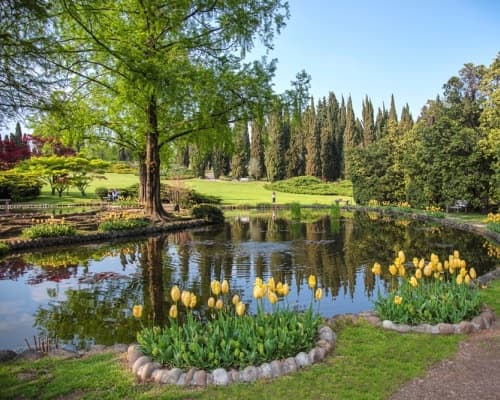A few kilometres from Lake Garda, in the beautiful location of Valeggio sul Mincio in the province of Verona, there is one of the most picturesque and visited natural parks in Europe: the Sigurtà Garden Park.
This naturalistic oasis covers an area of 600,000 square metres, and in 2023 it was awarded with the Garden Tourism Award as one of the most deserving gardens to visit in the world. This award is in addition to the previous ones, after being named Italy's Most Beautiful Park in 2013 and Europe's Second Most Beautiful Park in 2015.
During springtime, the Sigurtà Garden Park awakens with the blossoming of a multitude of tulips, hyacinths and daffodils, creating a spectacle of nature that leaves you speechless. The Tulipanomania Festival celebrates this extraordinary natural event every year, attracting an ever-increasing number of tourists and nature lovers.
Before going into detail about the Tulipanomania Festival, I'd like to introduce some basic concepts about tulips. This marvellous plant, a symbol of elegance and beauty, has a fascinating history, full of curious facts.
The origins of the tulip
The tulip belongs to the Liliaceae family, native to the area that is now known as southern China and the Tibetan Plateau. The first tulips as a genus date back around 6 million years. Over the centuries they spread westwards, evolving into different species, each adapted to specific environments.
Currently, over half of the wild tulip varieties grow on the slopes of the Tien Shan and Pamir mountains. Other natural habitats include the Caucasus, the Zagros and Taurus mountains, the Balkans, the Crimea, the Eurasian steppe and the mountains of the Mediterranean. The names of the species often derive from their habitat (e.g. T. Montana for the mountains, T. Sylvestris for the forests), from their geographical region (T. Uzbekistanica, T. Hungarica) or in honour of a botanist (T. Lemmersii, T. Clusiana).
Characteristics of the tulip
The most distinctive part is the flower, which can have a wide range of shapes and colours combined together. The tulip always has six petals, six stamens and a pistil. The flower is also the sexual organ that allows the tulip to reproduce through seeds, which develop inside a pod. The leaves play a crucial role in gathering energy through the process of photosynthesis, which is transported through the stem to all the other parts of the plant.
Inside the bulb, located underground, there is a small plant with a fully formed flower, organs and leaves, as well as a new bulb that will grow until it ripens. Everything is enclosed and protected by the brown tunic. Inside this are stored the sugars necessary for the plant to develop its roots, absorb water and favour the growth of the shoot.
The spread of the tulip in Turkey
In the 10th century, nomadic Turkish tribes migrated west from Central Asia and probably saw tulips growing wild along the mountain paths that connected the East to the West. Settling in Persia, they discovered that the tulip was already known and much appreciated in these lands.
In the 11th century, these populations continued their migration into the lands of the Byzantine empire, in the area that is now Turkey. After the rise of the House of Osman and the conquest of Constantinople (Istanbul) in 1453, the Ottoman sultans began transforming the gardens of their palaces into veritable Edens, introducing plants and flowers of every kind, including tulips, from all over the empire.
The arrival of the tulip in Europe
During the 16th century, some European diplomats and traders visiting the Ottoman Empire were fascinated by these marvellous gardens and the Ottoman admiration for tulips. The term tulip appeared for the first time in 1508 in the Diarii of the Venetian historian Marino Sanuto. Quite probably the Venetians played a key role in introducing the name tulipan to indicate the flower. It could derive from the word turban, the traditional Ottoman head covering, given the similarity in shape with the tulip.
A crucial figure in the spread of the tulip in Europe was Ogier de Busbecq, ambassador of the Habsburgs to the Ottoman court. In Vienna, the Dutch botanist Carolus Clusius began to study tulips. In 1593, Clusius founded the botanical garden at the University of Leiden in the Netherlands, taking his collection of bulbs with him. This event represented the starting point for tulip cultivation in Holland, creating a deep and indissoluble bond between this country and tulips.
The Tulipanomania Festival at Sigurtà Garden Park
From 8 March to the end of April, the landscape of the Sigurtà Garden Park is transformed into a blaze of colour and scent. The 2025 edition of the Tulipanomania Festival boasts the impressive number of one million tulips, hyacinths and daffodils, all planted by hand during the winter months.
Scattered throughout the 600,000 square metres of the park, there are hundreds of varieties of tulips to admire, including early, mid and late bloomers. Some are characterised by delicate pastel shades, others have more vivid colours and linear or jagged shapes. The flowers are skilfully arranged in flowerbeds that are redesigned year after year, placed on the ground, in watery spaces, on balconies or in random order in the shade of hornbeam and oak woods.
The Tulipanomania Festival, which is now recognised as the most important flowering event in Italy and the second most important in Europe, began back in 2005 with 5,000 tulips of various colours. Edition after edition, the park has been transformed into its current appearance, thanks to in-depth studies and a particular dedication to research.
Giuseppe Inga Sigurtà (owner of the Park) and his team begin, almost a year before flowering, to carefully select the best varieties of tulips and to plan the new flowerbeds. During the autumn months, the gardeners proceed with planting the bulbs, one by one, in different areas of the park.
The success of this meticulous work is demonstrated by the numerous awards won by the Sigurtà Garden Park over the years. Awards such as Most Beautiful Bloom in Italy 2016, Most Beautiful Bloom in the World 2019, Best Tulip Festival in the World 2022 and the World Tulip Innovation Award 2024, underline the very high level that this event has reached.
One of the great new features of the 2025 edition is the Show Garden, an area of about 2,000 square metres located near the entrance, where almost 100 varieties of tulips are on display. Along the perimeter there are 5 hexagonal totems, 2 metres high, with 30 descriptive panels, offering in-depth information on ancient history, Turkish tulip culture, flowering in Holland and the evolution of the park itself.
The descriptive labels are very useful and help you to understand the peculiarities of fascinating species such as the Lingerie tulip with its fringed edges, the pink-toned Marathon Champion, the World Peace that fades to yellow and orange, the Apricot Impression that recalls the shades of apricot, the dark-toned Canyon, the Negrita with its purple petals, the refined Sun lover with its yellow-orange petals, the Super Parrot that recalls the wings of a parrot, the Crown of Negrita with its dark colours and crown shape, the Queen of the Night with black petals, the unusual Continental with a black stem, the rare Alise widespread in Japan or the Banja Luka with red and yellow petals.
If you love photography too, the Tulipanomania Festival is the best opportunity to visit the park and take some unforgettable photos. Along the Viale delle Aiuole Fiorite there are colourful installations, while the floating flowerbeds that move in the breeze create a magical optical effect in the ponds and in the Water Gardens.
The balconies in bloom, adorned with wooden boxes, or the benches surrounded by tulips, are the ideal places to take a break and enjoy the landscape. To complete the natural picture, a variety of multicoloured planters, 20 types of daffodils and 2 varieties of allium with lilac and purple shades, create a unique visual harmony.
Travel tips - The Sigurtà Garden Park is located at Via Cavour, 1 in Valeggio sul Mincio (VR) and is easily reachable by car from Peschiera del Garda following the regional road SR249 for about 13 kilometres, or by bicycle following the Mincio cycle path. There are many options for visiting: on foot, by bicycle (either your own or an electric one hired at the park), on board the panoramic train (perfect for groups and equipped with a voiceover describing the most evocative points), or using electric golf carts and shuttles. Tickets can be purchased online at www.sigurta.it or directly at the ticket office of the park.
Image gallery Tulipanomania Festival
Click on the button below to open the image gallery.
How to get to the Sigurtà Garden Park
Click on the button below to open the detailed map.
What to see on Lake Garda
Many other sights await you, discover them below!






